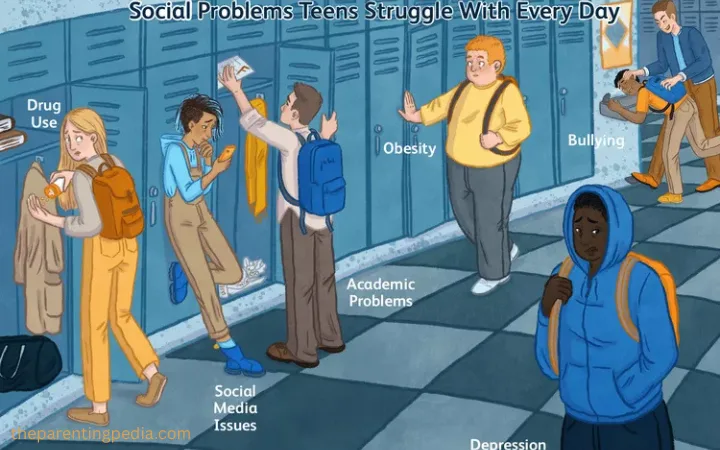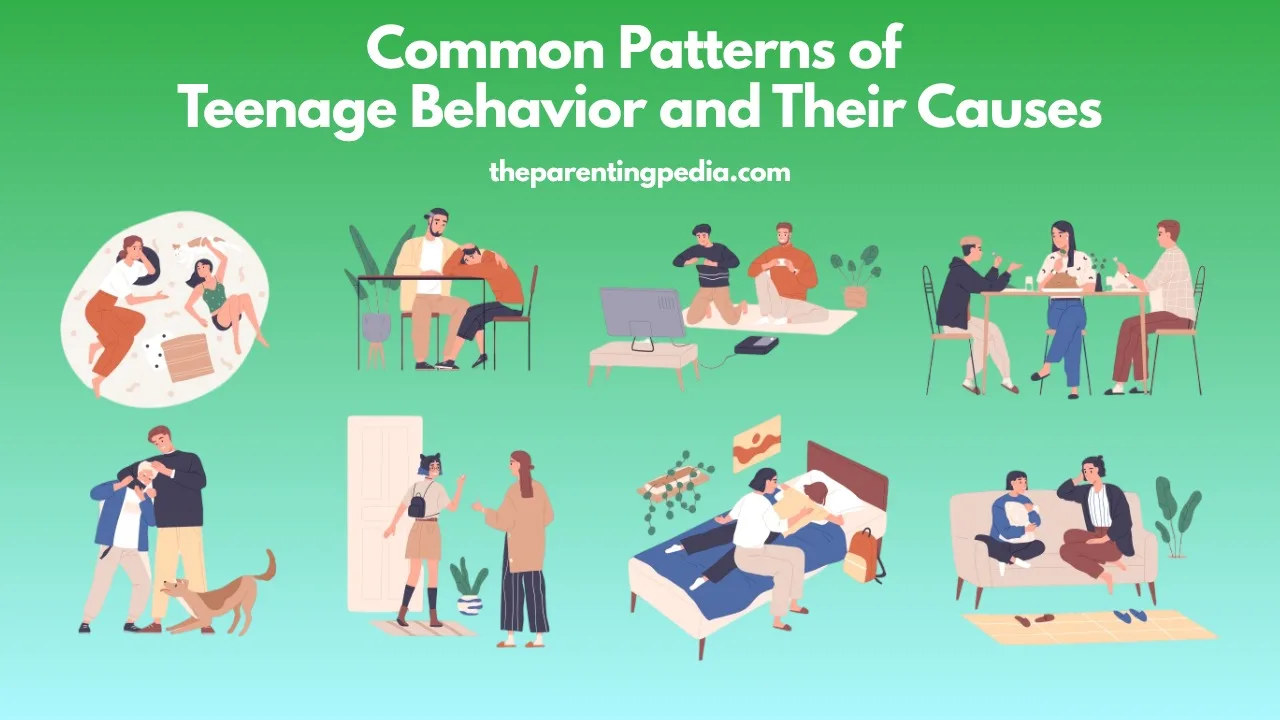Teenage years are described as time of change, growth and discovery. Parents notice sudden mood swings, new interests or even challenging attitudes that were not present in children during childhood. These changes can be confusing as well as frustrating for both parents and teens. However, understanding such behavior of teenage children and reasons for such behavior can make this stage easier to cross. This article discuss about the most common patterns of teenage behavior and explains the physical, emotional, and social factors that are reasons for this behavior.

Common Patterns Of Teenage Behavior
1. The Search for Independence
One of the most recognizable patterns of teenage behavior is the growing desire for independence. Teenagers begin to make their own choices about clothing, friendships, hobbies and regarding various other activities. They may resist rules or question authority figures in their lives including parents and teachers.
This behavior is a natural part of teenage development. As the brain matures, teens start forming their own identity different from their parents. They want to prove to others that they can think and act for themselves. While this independence can lead to disagreements at home, it is an important step for teenage children toward becoming a responsible adult.
Parents can support this pattern by setting clear boundaries for teenagers while allowing reasonable freedom. Encouraging open discussions with teenagers rather than strict control helps them feel respected and understood.
2. Increased Importance of Peer Relationships
During adolescence, friendships become a central and important part of life. Teens often value their peers opinions more than their parents advice. This shift in priorities of teenagers is a normal part of teenage behavior and helps young children learn how to form social connections and gain a sense of belonging with others.
Friends influence everything from fashion, clothes and music preferences to attitudes and risk-taking. While positive friendships can boost confidence and teach positive habits like cooperation to teenagers, negative pressure from friends can lead to poor choices such as skipping school or experimenting with harmful substances like alcohol and drugs.
Parents can guide their teens by encouraging friendships with children that influence them positively and staying involved in their social life without intruding. Asking open-ended questions about friends and activities in healthy way to teenagers can help parents stay informed and connected.
Why struggle with uploads when you can share images in seconds?
😎 Just drag, drop & get a link 👉 https://imagelink.online
3. Emotional Ups and Downs
Emotional changes are another common pattern of teenage behavior. Teenagers may seem cheerful one moment and withdrawn or angry the very next moment. These mood swings are often caused in teenagers by hormonal changes that they face during puberty and by increased brain activity in the emotional centers of the brain as they develop.
Teenagers also face pressure in life from school, friendships and even social media, which can intensify emotional ups and downs in their behavior. They may also struggle to balance schoolwork with their desire for social acceptance by others.
Parents should remember that emotional instability in teenagers does not always mean serious problems. Listening without judgment and providing calm support and guidance to teenage children can help them manage their feelings more effectively. If mood changes are extreme or long lasting in teenagers, professional guidance or help from a counselor may be helpful.
4. Risk Taking and Curiosity
Risk taking is one of the most challenging aspects of teenage behavior. Teens may drive too fast, break curfews or try things that they know are risky. Although such actions of teenagers can worry parents, this tendency is linked to brain development. The part of the brain that controls impulses and predicts consequences is still developing in teenage children during adolescence, while the reward centers are highly active. This imbalance leads teens to seek excitement without fully considering the risks.
Risk taking is not always negative, it can also motivate teens to try new experiences, join sports or pursue creative goals. The key is guiding this curiosity in safe directions by parents. Parents can discuss possible outcomes calmly with teens and provide opportunities for healthy risks, such as learning new skills or taking leadership roles in school activities.
Also Read: Challenges Faced by Parents of Children with ADHD
5. Self-Consciousness and Body Image
Another noticeable pattern of teenage behavior is increased self-awareness and concern about appearance. Teens often compare themselves to peers or celebrities, leading to insecurities about body image, weight or style. This sensitivity develops because teens are figuring out how they fit into the world. Social media plays a major role by showing idealized images that can make young people feel inadequate.
Parents can help by emphasizing qualities beyond looks such as kindness, creativity and intelligence. Encouraging healthy eating and physical activity without focusing on weight can also promote a positive self-image. Most importantly, parents should model self-acceptance and confidence in their own behavior in front of teenage children.
6. Privacy and Withdrawal
Many parents notice that their once talkative child becomes more private during the teenage years. Teens may spend more time in their room, prefer texting friends to family conversations or keep secrets with parents. This withdrawal is another normal pattern of teenage behavior, reflecting their need for personal space and independence.
While privacy is healthy, parents should stay observant for warning signs such as extreme isolation, sudden drop in grades or changes in sleep and eating habits, which might indicate deeper emotional struggles in teens.
Maintaining open communication with teenagers is key. Instead of forcing conversations, parents can show they are available for their children and willing to listen when the teen is ready to talk. Respecting some boundaries helps build trust and encourages honesty in teens.
7. Rebellion and Rule Testing
Rebellion is often associated with adolescence. Teens may challenge household rules, argue more or experiment with behaviors parents disapprove of. This pattern of teenage behavior arises as young people test limits and assert independence.
Rebellion can be mild in children like changing hairstyles or expressing strong opinions or more serious, such as skipping responsibilities or lying. How parents respond to such situations makes a big difference. Setting clear expectations and consistent consequences helps teens learn accountability without feeling controlled.
Open discussions about values and reasoning behind rules can also reduce conflicts with children. When teens understand the purpose of boundaries, they are more likely to respect them.

Understanding the Causes Behind Teenage Behavior
The causes of teenage behavior are a mix of biological, psychological and environmental factors:
Biological causes: Hormonal changes during puberty affect mood, energy and emotions. Brain development continues until the mid twenties, influencing decision making and impulse control of teenagers.
Psychological causes: Teens are forming their identity and trying to build self-esteem during adolescence. They often experiment with different type of roles and behaviors to find where they fit in.
Social causes: Peer influence, media exposure and family relationships all shape how teenagers think and act. A supportive environment can help teens develop confidence and make healthy choices in life.
Recognizing these causes allows parents to respond with patience and empathy rather than frustration towards teenage children.
Conclusion
Understanding teenage behavior is essential for building strong, trusting relationships between parents and their children. Most of the challenges parents face during adolescence are part of normal growth and development. By learning the reasons behind these behaviors ranging from the search for independence to peer influence and emotional changes, parents can guide their teen children more effectively. Rather than seeing this stage as a struggle, parents can view it as an opportunity to help their children grow into capable, confident young adults.

FAQ
What is a typical teenage behavior?
Typical teenage behavior includes mood swings, a desire for independence, strong peer influence and curiosity about new experiences. Teens often question authority, seek identity and value friendships deeply. These behaviors are normal as teenagers learn to make decisions, express themselves and develop confidence during their transition to adulthood.
What are the most common teenage problems?
The most common teenage problems include peer pressure, low self-esteem, academic stress and family conflicts. Teens also struggle with body image issues, social media influence and mental health challenges like anxiety or depression. Balancing school, friendships and identity often leads to confusion and emotional ups and downs during adolescence.
What are some typical teen behavioral changes?
Typical teen behavior might include: Spending more time with friends and less time with family. Spending more time in their room alone. Trying out different personal styles (clothing, hair, makeup, etc.).
What are the most common teenage problems?
The common teenage problems that teenagers face today are usually related to:
> Self-Esteem and Body Image.
> Stress.
> Bullying.
> Depression.
> Cyber Addiction.
> Drinking and Smoking.
> Teen Pregnancy.
> Underage Sex.
What causes teenage mood swings?
It’s not unusual for teens’ moods to shift quickly and for their emotional responses to be strong. That’s due, in part, to the developmental changes in brain activity and to the fluctuations in hormones that happen in an adolescent’s body.
Why is my teenage daughter so angry?
A teenager’s anger can stem from normal adolescent developmental factors like hormonal changes and a rapidly developing brain, which impacts emotional regulation. However, it can also signal underlying issues such as stress, anxiety, bullying, family problems, mental health conditions, or even substance use. It’s important to foster open communication, set consistent boundaries, and observe for signs of more significant problems to provide appropriate support for your daughter.
Get inspired by simple yet powerful business opportunities you can explore now.
